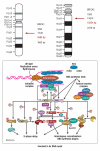Hereditary breast and ovarian cancer: new genes, new treatments, new concepts
- PMID: 21637635
- PMCID: PMC3106175
- DOI: 10.3238/arztebl.2011.0323
Hereditary breast and ovarian cancer: new genes, new treatments, new concepts
Abstract
Background: Every year, 60,000 women in Germany are found to have breast cancer, and 9000 to have ovarian cancer. Familial clustering of carcinoma is seen in about 20% of cases.
Methods: We selectively review relevant articles published up to December 2010 that were retrieved by a search in PubMed, and we also discuss findings from the experience of the German Consortium for Hereditary Breast and Ovarian Cancer.
Results: High risk is conferred by the highly penetrant BRCA1 and BRCA2 genes as well as by other genes such as RAD51C. Genes for breast cancer that were originally designated as moderately penetrant display higher penetrance than previously thought in families with a hereditary predisposition. The role these genes play in DNA repair is thought to explain why tumors associated with them are sensitive to platin derivatives and PARP inhibitors. In carriers of BRCA1 and BRCA2, prophylactic bilateral mastectomy and adnexectomy significantly lowers the incidence of breast and ovarian cancer. Moreover, prophylactic adnexectomy also lowers the breast-and-ovarian-cancer-specific mortality, as well as the overall mortality. If a woman bearing a mutation develops cancer in one breast, her risk of developing cancer in the other breast depends on the particular gene that is mutated and on her age at the onset of disease.
Conclusion: About half of all monogenically determined carcinomas of the breast and ovary are due to a mutation in one or the other of the highly penetrant BRCA genes (BRCA1 and BRCA2). Women carrying a mutated gene have an 80% to 90% chance of developing breast cancer and a 20% to 50% chance of developing ovarian cancer. Other predisposing genes for breast and ovarian cancer have been identified. Clinicians should develop and implement evidence-based treatments on the basis of these new findings.
Figures



References
-
- Farmer H, McCabe N, Lord CJ, et al. Targeting the DNA repair defect in BRCA mutant cells as a therapeutic strategy. Nature. 2005;434:917–921. - PubMed
-
- Fong PC, Boss DS, Yap TA, et al. Inhibition of poly(ADP-ribose) polyme-rase in tumors from BRCA mutation carriers. N Engl J Med. 2009;361:123–134. - PubMed
-
- Byrski T, Gronwald J, Huzarski T, et al. Pathologic complete response rates in young women with BRCA1-positive breast cancers after neoadjuvant chemotherapy. J Clin Oncol. 2010;28:375–379. - PubMed
-
- Audeh MW, Carmichael J, Penson RT, et al. Oral poly(ADP-ribose) polymerase inhibitor olaparib in patients with BRCA1 or BRCA2 mutations and recurrent ovarian cancer: a proof-of-concept trial. Lancet. 2010;24(376):245–251. - PubMed
Publication types
MeSH terms
Substances
LinkOut - more resources
Full Text Sources
Medical
Research Materials
Miscellaneous

